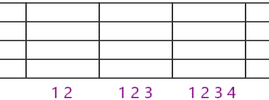Time Signatures
Measure Total Count

Rhythm adds values together until we get a full count/beat. The values are the notes and rests that span a full measure. These note values are equal fractions of a whole (half, quarter, eighth, sixteenth).
Measures themselves each have an equal total (not counting incomplete measures, since we're just learning the basics). They are blocks of equal time. A single measure meters the rhythm of the notes for that part of a song.
Measures' total beats are usually divided into two (like 2,4, or 8), or into three beats (like 3 or 6). So a measure may have 4 beats per measure, or, in another song, 6 beats per measure. Each measure will continue with the same number of beats per measure, until the end of the song. The notes and rests within a measure add up to a measure's total count.
Note Divisions

In contrast to measures' different beat types, notes and rests' fractional division remains the same, regardless of measures' beat or count. For example, a measure with four beats, would need four quarter notes (1,2,3,4). For the same measure, eight eighth notes would be needed to fill the measure's count (1& 2& 3& 4&).
But, for a measure with a count/beat of three (odd), we must have only three quarter notes for each beat (1,2,3). Likewise, six eighth notes are needed to fill the same measure's beat (1& 2& 3&).
- Measures divide the background beat.
- Notes divide the measures' total count.
The following may be easier to understand by reviewing the Sheet Music page.
Notes in Measures
We may change the type of note that gets one beat in a measure. The written music notates the song more efficiently.
Within a four count measure, let's use the eighth note for one whole beat (1&). It now takes on the quarter note's previous count of one beat (1,2,3,4). Standing alone, notes' fractional divisions never change. They divide in half, divide half of that, etc.
Since the eighth is now one whole beat, we need four eighth notes (1,2,3,4) to complete a measure. Therefore, we need only two quarter notes (1,2). We need only one half note as well, to fill the beat (feel the beat).
This is a result of changing a note type, that gets one beat, in a measure of four beats |1 2 3 4|.
Within a measure of three counts, changing the note that gets one beat/count into an eighth note, means that a full measure would have three eighth notes (1,2,3). Likewise six sixteenth notes (dividing the eighths, 1& 2& 3&) are needed for a full measure.
Interestingly, our number of quarter notes could only be one, because not enough counts are in the measure, to have any more quarter notes (two eighths equal a quarter). Of course, with one quarter note (two beats), we would have to fill up the rest of the measure with other types of notes/rests, to make a three count measure.

Beats in a Measure
Let's express these measure/note relations visually.
- On top, use a number for the measure's count/beat
- On bottom, use a number for the type of note that gets one beat

4/4
(1& 2& 3& 4&)
The top four means there are four beats in a measure (every measure in the song). The bottom four means a quarter (1/4) note gets one beat. These two numbers stacked are called a Time Signature. This appears at the beginning of all the measures in a song. We'll know before we start reading the notes what rhythm to play.

3/4
(1& 2& 3&)
The top number has changed to three beats per measure. The bottom number is still a quarter note (1/4) that gets one beat.

6/8
(1 2 3 4 5 6)
The top number is now six beats per measure. The bottom number change represents the eighth note (1/8) as one beat. So we must have six eighth notes per measure (for a full measure). Therefore we need three quarter notes per measure (which sounds like a Triplet).

2/2
(1& 2&)
The top 2 shows two beats per measure (short!), and the bottom 2 shows a half note (1/2) getting one beat. Four quarter notes form a complete measure (quarter notes are half of a half note). Here, two measures each have their beat of 2 counts. Since the beat is so short, perhaps this is for a fast song.
In each time signature, change the top number for the measure's beat count, then change the bottom number for the note's type (half, quarter, eighth).
- measure beat / note type
- 4 / 4 = four beats per measure / quarter note gets one beat
- 3 / 4 = three beats per measure / quarter note gets one beat
- 6 / 8 = six beats per measure / eighth note gets one beat
- 2 / 2 = two beats per measure / half note gets one beat
In summary, different note types may equal one beat, according to a time signature. The note types themselves keep their value divisions, like a half, quarter, eighth, or sixteenth (1/2, 1/4, 1/8, 1/16).
Measures divide into equal parts the background beat of a song. And they visually help us to see at what point we are in a song, like a status bar.
For a better understanding of note and rest divisions: Rhythm Basics
The next page is not about rhythm, but about sound through Key Signatures.